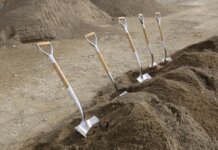
Greg Canfield will be the first to tell you that when he became director of the Alabama Development Office — and later secretary of Commerce — his resume didn’t scream “economic development.”
“I would be lying if I didn’t say there weren’t a lot of eyebrows raised when my name was announced,” he says of his appointment by then-Gov. Robert Bentley. “A lot of people in economic development in the state were caught off-guard.”
But Canfield has silenced many of his naysayers in the decade he’s been on the job, leading a rebranding of Alabama’s economic development efforts, overseeing the creation of several workforce development areas and, most importantly, seeing an influx of companies to the state.
“Throughout Greg’s tenure, we have landed major development projects like the coveted Mazda Toyota plant and attracted more businesses to even the most rural part of our state,” says Gov. Kay Ivey, Bentley’s successor. “Alabama has a top-ranked business climate, and more and more companies are choosing to do business here, and Greg works tirelessly to ensure that remains the case.”
BIRTH OF A SALESMAN
Canfield grew up in the Powderly Park area of Birmingham, studying business at the University of Alabama before finishing up a finance degree at the University of Alabama at Birmingham. Canfield moved back to Birmingham because his wife-to-be, Denise, launched her banking career in the city.
“My goal was to become a stockbroker, but I couldn’t open the door properly for that to happen,” he says.
Instead, Canfield went into sales, forging a successful career at Purolator, Consolidated Freightways and Transus Freight Systems.
But with his wife still in banking, children being born and Canfield on the road many weekdays, opportunity came knocking in the form of the insurance industry, and Canfield eventually opened and ran his own insurance and financial services company for 15 years in Vestavia Hills.
That led to his first real taste of economic development and politics.
Canfield and some others, disenchanted with the lack of direction of Vestavia Hills, co-founded Voters with Vision (V3), an effort that brought new government to the Birmingham suburb and put Canfield on the City Council. In 2006, Canfield won the House seat vacated by Jim Carnes in District 48.
He was in his second term when Bentley appointed him to run the Alabama Development Office in 2011.
EVOLVING JOB
“There were aspects of the job I took to right away,” Canfield says. “Managing the team, creating a vision for the department and working with the team to establish that vision came pretty easily. I did drink from the firehose for about three months on the more technical aspects of economic development that I had to become accustomed to, particularly on the state level.”
One of the first things that struck Canfield was that the Alabama Development Office, despite some successes along the way, didn’t have a clear brand.
“We were allowing the State of Alabama and our economic development efforts to be defined by third parties, usually outside of the state, which often didn’t characterize Alabama in the most positive light,” he says.
And people, especially from other countries, didn’t really know what the ADO did.
“The easy thing was to find a name for our agency that was understood internationally, and Department of Commerce is easily understood,” says Canfield, whose job title changed from director to secretary. “The part that was hard was developing a branding strategy where the brand can tell our story and do much of the marketing for us.”
With the help of Big Communications in Birmingham, Made in Alabama was launched in March 2015.
FUTURE-FOCUSED ECONOMY
Armed with a new brand and a new way to incentivize companies to do business in the state, Canfield and his team went to work, not only to raise wages for the average Alabamian, but to diversify and make more future-focused an economy that was already seeing great success luring major automakers to the area.
“Even though you can build the argument that in the automotive industry we are very dense and have had lots of success, we don’t have to rely just on the automotive sector in our economy,” he says. “We have a burgeoning aerospace economy. We’ve continued to grow our forest-product economy. We’ve continued to grow our agricultural and food services through a strategy of improving our distributional logistics in the state. We’ve been very intentional about what we do.”
That intentional growth includes building the state into an enticing space for research and innovation, including not only scientific research being conducted by the likes of HudsonAlpha, Evonik and Southern Research, but more entrepreneurial successes like Shipt and, most recently, Landing, which moved its headquarters from San Francisco to Birmingham.
“We’ve helped create and support this transition into a system of real innovation and early-state entrepreneurship and the growth of that,” Canfield says. “We’re testing this perception that you’ve got to be on the East Coast or the West Coast to have a chance at being effective as an innovator in the tech world. We’re disproving that. We’re showing that you can be in a Birmingham, Alabama, or a Huntsville, Alabama, or an Auburn or a Mobile or a Montgomery, and you can have the workforce that you need with the talent you need, with the affordability, but also with a lifestyle that’s attractive to people.”
All of those things are pluses for Alabama, Canfield says, along with recent improvements at the Port of Mobile (a massive cold-storage capability and a roll-on/roll-off facility), the state’s five Class 1 railroads, and a network of interstates that connects 50% of the U.S. within a 24-hour drive.
CHALLENGES REMAIN
Two things bubble to the surface when Canfield is asked about challenges that remain when wooing companies to the state — the availability of land and a qualified workforce.
“You have to have available land that can be developed for the types of use a project brings, and that’s been one of our biggest challenges lately,” he says. “As we have developed more of a focus on rural development, it has been easier to find certain types of sites that are important and workable for some of these projects, so that’s been good.”
The other challenge is a bit more vexing.
“Workforce is paramount, and Alabama and 49 other states are wrestling with this issue of the availability of a workforce,” he says. “During COVID, we’ve seen millions of people remove themselves from the workforce because they have a variety of challenges that prevent them from working.”
Tackling the workforce issue is a priority of Ivey’s, so Canfield and his department have put programs in place to help solve the issue, from the Alabama Office of Apprenticeship to efforts involving the community colleges, Department of Labor, Alabama State Department of Education and others.
“I don’t think I’ve ever seen as much collaboration as we have wrapped around this issue,” he says. “We’ve got to find ways to give people the motivation and the incentive to reenter the workforce in large numbers.”
AHA MOMENTS
Despite those challenges, selling Alabama to potential companies can be easy — if Canfield and his crew can get them here.
“We want the company and the company’s executives and their spouses and families to come and visit, because it is all about the perception that exists that flyover states have nothing to offer,” he says.
When they do visit, they usually are impressed, Canfield says.
“Invariably, when people visit Alabama, they do have that ‘aha moment’ where they say, ‘I had no idea you had this many mountains or this much forest;’ or ‘I didn’t realize you had performing arts or art museums; I didn’t realize you had beautiful beaches; I didn’t know you had these rivers; I didn’t know you had all these lakes where I can fish or all this area where I can hunt or trails where I can hike, or all these great restaurants,’” he says. “It’s unbelievable. When people come to visit, they do come away with a changed perspective about Alabama.”
Alec Harvey is executive editor of Business Alabama and photographer Julie Bennett is an Auburn-based freelance contributor.
This story originally appeared in the December 2021 issue of Business Alabama magazine.



